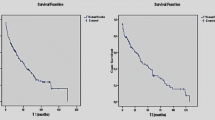Summary
Shunt complications and revisions are common in hydrocephalic patients treated with a ventriculo-atrial or a ventriculo-peritoneal shunt. The reported revision rate differs very much but the rate of revision is close to 50% in many papers. Data from 884 hydrocephalic patients treated with various shunt types in the period 1958–1989 were recorded retrospectively in order to evaluate the frequency of revision for various shunt types and secondly to analyse the specific reasons for the shunt revisions.
The rate of shunt revision was 45%. The Pudenz shunt was revised more often (62%) than the remaining shunt types. The Hakim and the Orbis-Sigma shunts had fewer revisions (35% and 27%, respectively) than the other observed shunt types. A defect of or an obstruction in the ventricular catheters was a frequent cause of revision followed by a defect or an obstruction of the distal catheter, a displacement of the distal catheter and an acute infection. Because of the higher rate of revision for the Pudenz shunt the rate of the above mentioned specific complications is also higher in most of the subgroups for that specific shunt type. Driven by these experiences it is reasonable to seek to develop and introduce new shunt types in an attempt to reduce the complication rate.
Similar content being viewed by others
References
Davidson RI (1976) Peritoneal bypass in the treatment of hydrocephalus: historical review and abdominal complications. J Neurol Neurosurg Psychiatry 39: 640–646
Fernell E, Wendt L (1985) Ventriculo-atrial or ventriculo-peritoneal shunts in the treatment of hydrocephalus in children. Z Kinderchir 40 [Suppl I]: 12–14
Giuffre R, Palma L, Fontana M (1979) Extracranial CSF shunting for infantile non-tumoral hydrocephalus — a retrospective analysis of 360 cases. Clin Neurol Neurosurg 81–83: 199–210
Goldblum RM, Pelley RP, O'Donell AA, Pyron D, Heggers JP (1992) Antibodies to silicone elastomers and reactions to ventriculoperitoneal shunts. Lancet 340: 510–513
Gower DJ, Lewis JC, Kelly DL (1984) Sterile shunt malfunction. Neurosurg 61: 1079–1084
Gruber R (1979) Zur Therapie des kindlichen Hydrozephalus. Z Kinderchir 28: 212–225
Guidetti B, Occhipinti E, Riccio A (1969) Ventriculo-atrial shunt in 200 cases of non-tumoral hydrocephalus in children: remarks on the diagnostic criteria, postoperative complications and long-term results. Acta Neurochir (Wien) 21: 295–308
Haase J, Bang F, Tange M (1987) Danish experience with the one-piece shunt. Childs Nerv Syst 3: 93–96
Haines SJ, Taylor F (1982) Phrophylactic methicillin for shunt operations: effects on the incidence of shunt malfunction and infection. Childs Brain 9: 10–22
Hoffman HJ, Smith SM (1986) The use of shunting devices for cerebrospinal fluid in Canada. Can J Neurol Sci 13: 81–87
Ignelzi RJ, Kirsch WM (1975) Follow-up analysis of ventriculoperitoneal and ventriculoatrial shunts for hydrocephalus, J Neurosurg 42: 679–682
Ivan LP, Choo SH, Ventueyra ECG (1980) Complications of ventriculoatrial and ventriculoperitoneal shunts in a New Children's Hospital. Can J Surg 23: 566–568
Jackson IJ, Snodgrass SR (1955) Peritoneal shunts in the treatment of hydrocephalus and increased intracranial pressure. J Neurosurg 12: 216–222
Kaiser G, Bittel M (1992) Preliminary experience with the Orbis-Sigma system as a ventriculo-peritoneal shunt. Eur J Pediatr Surg 2: 186–187
Kossovsky N, Snow RB (1989) Clinical-pathological analysis of failed central nervous system fluid shunts. J Biomed Mat Res 23: 73–86
Little JR, Rhoton AL, Mellinger JF (1972) Comparison of ventriculoperitoneal and ventriculoatrial shunt for hydrocephalus in children. Mayo Clin Proc 47: 396–401
Mazza C, Pasqualin A, Pian RD (1980) Results of treatment with ventriculoatrial and ventriculoperitoneal shunt in infantile nontumoral hydrocephalus. Childs Brain 7: 1–14
Metzemaekers JDM, Beks JWF, Popta JSV (1987) Cerebrospinal fluid shunting for hydrocephalus: a retrospective analysis. Acta Neurochir (Wien) 88: 75–78
Nulsen FE, Spitz EB (1952) Treatment of hydrocephalus by direct shunt from ventricle to jugular vein. Surg Forum 2: 399–403
Puca A, Anile C, Maira G, Rossi G (1991) Cerebrospinal fluid shunting for hydrocephalus in the adult: factors related to shunt revision. Neurosurgery 29: 822–826
Raimondi AJ, Robinson JS, Kuwaruma K (1977) Complications of ventriculoperitoneal shunting and a critical comparison of the three-piece and one-piece systems. Childs Brain 3: 321–342
Sainte-Rose C, Hoffman HJ, Hirsch J-F (1989) Shunt failure. Concepts Pediatr Neurosurg 9: 7–20
Syers MP (1976) Shunt complications. Clin Neurosurg 23: 393–400
Schoenbaum SC, Gardner P, Shillito J (1975) Infections of cerebrospinal fluid shunts: epidemiology, clinical manifestations, and therapy. J Infect Dis 131 (5): 543–552
Sekhar L, Moossy J, Guthkelch AN (1982) Malfunctioning ventriculoperitoneal shunts. Clinical and pathological features. J Neurosurg 56: 411–416
Snow RB, Kossovsky N (1989) Hypersensitivity reaction association with sterile ventriculoperitoneal shunt malfunction. Surg Neurol 1: 209–214
Steinbok P, Thompson GB (1976) Complications of ventriculo-vascular shunts: computer analysis of etiological factors. Surg Neurol 5: 31–35
Weiss SR, Raskind R (1969) Twenty-two cases of hydrocephalus treated with a silastic ventriculoperitoneal shunt. Int Surg 51: 13–19
Author information
Authors and Affiliations
Rights and permissions
About this article
Cite this article
Borgbjerg, B.M., Gjerris, F., Albeck, M.J. et al. Frequency and causes of shunt revisions in different cerebrospinal fluid shunt types. Acta neurochir 136, 189–194 (1995). https://doi.org/10.1007/BF01410625
Issue Date:
DOI: https://doi.org/10.1007/BF01410625




